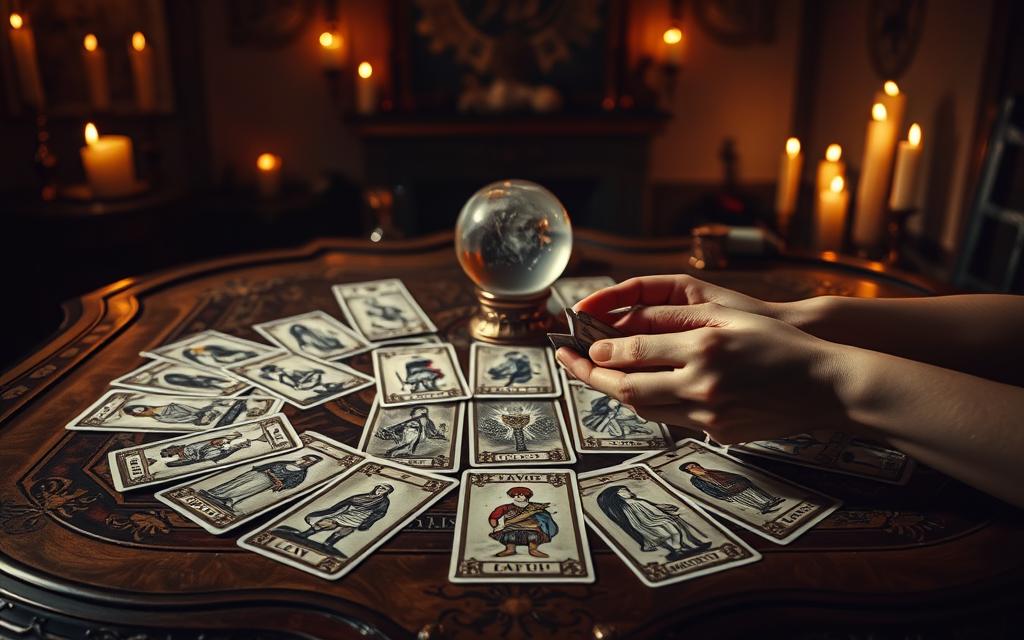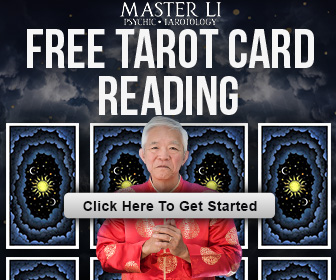Tarot card reading has been a source of fascination for many, offering insights into one’s life, future, and personal growth. A crucial aspect of interpreting tarot card meanings lies in understanding the orientation of the cards drawn.
The distinction between upright and reversed tarot cards can significantly influence the reading’s outcome. While upright cards generally symbolize the straightforward interpretation of their symbolism, reversed cards often indicate a blockage, opposite, or a more complex interpretation of the card’s usual meaning.
Understanding the nuances of upright vs reversed tarot cards is essential for a comprehensive tarot card reading. This knowledge enables readers to provide more accurate and detailed insights, enhancing the overall reading experience.
Table of Contents
The Basics of Tarot Card Reading
To grasp the nuances of tarot card reading, one must first understand the composition of a tarot deck. A standard tarot deck is composed of 78 cards, each with its own unique symbolism and meaning.
The Structure of a Tarot Deck
A tarot deck is divided into two main categories: the Major Arcana and the Minor Arcana.
Major Arcana Cards
The Major Arcana consists of 22 cards that represent major life themes, archetypes, and transitions. These cards are numbered from 0 (The Fool) to 21 (The World).
Minor Arcana Suits
The Minor Arcana has 56 cards, divided into four suits similar to a regular playing card deck. Each suit represents a different aspect of life: Cups (emotions), Pentacles (material wealth), Swords (thoughts and communication), and Wands (creativity and action).
The Purpose and Process of Tarot Readings
Tarot readings are used for gaining insight, guidance, and self-reflection. The process involves shuffling the deck, laying out the cards in a specific pattern or spread, and interpreting their meanings based on their positions and relationships to each other. For more on various tarot spreads, visit 9 Tarot Spreads for Clarity.
Card Orientation in Spreads
The orientation of the cards (upright or reversed) can significantly affect the interpretation of a tarot reading. Understanding how to interpret cards in different orientations is crucial for a comprehensive understanding of the reading.
| Card Type | Upright Meaning | Reversed Meaning |
|---|---|---|
| Major Arcana | Major life themes, archetypes | Blocked or opposite themes |
| Minor Arcana | Situational, detailed insights | Internal, personal, or blocked aspects |
What Is the Difference Between Upright and Reversed Tarot Cards
In tarot readings, the difference between upright and reversed cards is not just about physical orientation but also about the depth of interpretation. The distinction between these two states can significantly influence the understanding of the tarot’s message.
Physical Orientation Explained
The physical orientation of a tarot card refers to its position relative to the reader. An upright tarot card is one that appears in its normal, intended position, while a reversed tarot card is upside down. This physical distinction is the foundation for different interpretations.
The orientation can occur randomly during the shuffling process or be intentionally managed by the reader. Some readers believe that the physical act of reversing a card can imbue it with a different kind of energy.
Energetic and Symbolic Differences
Upright and reversed tarot cards are believed to possess different energies and symbolisms. Upright cards typically represent the direct, intended meaning of the card, while reversed cards can signify a blockage, opposite, or alternative interpretation.
For instance, an upright card might symbolize a positive outcome, whereas its reversed counterpart could indicate a delay or negation of that outcome. This dichotomy allows for a more nuanced understanding of the tarot’s message.
“The reversed tarot card is not just the opposite; it’s a different perspective, a nuanced view that adds complexity to the reading.”
Historical Perspectives on Reversals
The use of reversed tarot cards has evolved over time. Historically, some tarot traditions did not consider reversals, interpreting cards based solely on their upright meanings. However, modern practice often incorporates reversals to add depth to readings.
The incorporation of reversed cards into tarot readings reflects the evolving nature of tarot interpretation, adapting to the needs and understandings of contemporary practitioners.
Interpreting Upright Tarot Cards
The interpretation of upright tarot cards is a fundamental skill for tarot enthusiasts and readers alike. Upright tarot cards are believed to represent the direct and straightforward interpretation of the card’s symbolism, making their understanding crucial for accurate tarot readings.
Traditional Meanings and Symbolism
Upright tarot cards draw upon traditional meanings and symbolism associated with each card. For instance, the Major Arcana cards are rich in symbolism, representing major life themes and transitions. Understanding these traditional meanings is essential for interpreting upright tarot cards effectively. The symbolism on each card, whether it be imagery, numbers, or figures, holds significance and contributes to the overall meaning of the card in a reading.
The Direct Energy of Upright Cards
Upright tarot cards are considered to embody the direct energy associated with the card’s symbolism. This direct energy is believed to influence the interpretation of the card in a tarot spread. For example, an upright card may signify a clear and straightforward message or energy, as opposed to the potentially blocked or reversed energy of a card that appears in the reversed position. Readers often rely on the tarot card symbolism to understand the nuances of the card’s energy and its application to the querent’s situation.
Reading Upright Cards in Different Positions
The position of an upright tarot card within a tarot spread can significantly affect its interpretation. Different positions may relate to various aspects of the querent’s life or question, such as past influences, current situations, or future outcomes. For instance, visiting a resource like Justice Tarot: Yes or No can provide insights into how specific cards are interpreted in different contexts. Mastering the art of interpreting upright cards in various positions is a key tarot reading technique that enhances the reader’s ability to provide detailed and relevant readings.
Understanding Reversed Tarot Cards
Reversed tarot cards introduce an additional dimension to tarot readings, challenging readers to consider alternative perspectives. When a card appears in the reversed position, it can significantly alter the interpretation of the tarot spread.
The interpretation of reversed tarot cards is a complex aspect of tarot reading, with various approaches to understanding their meanings. Let’s explore some common methods.
Common Approaches to Reversed Meanings
Tarot readers employ different techniques to interpret reversed cards, each offering unique insights.
The Blocked Energy Approach
The blocked energy approach suggests that a reversed card indicates a blockage or stagnation in the energy associated with the upright meaning of the card. For instance, if an upright card signifies positive change, its reversed counterpart might indicate resistance to change or delayed progress.
The Opposite Meaning Approach
Another method is the opposite meaning approach, where the reversed card is interpreted as having the opposite meaning of its upright counterpart. This can sometimes offer a straightforward reversal of the card’s usual interpretation, though it’s not always a simple flip.
Psychological Aspects of Reversals
Reversed tarot cards can also have psychological implications, suggesting inner conflicts or unconscious motivations. They can indicate areas where the querent’s perception or actions may be misaligned with their true desires or needs.
When Reversals Indicate Internal Challenges
Often, reversed cards point to internal challenges or personal issues that need to be addressed. For example, a reversed card that typically signifies love or relationships might indicate self-love issues or difficulties in forming healthy connections with others.
Understanding these nuances is key to a deeper tarot practice. By considering the context and the question being asked, readers can provide more nuanced and helpful interpretations.
Tarot readings that include reversed cards can offer a richer, more detailed understanding of a situation, encouraging a more thoughtful and reflective approach to tarot interpretation.
Practical Examples: How Meanings Transform
The distinction between upright and reversed tarot cards adds layers to the interpretation of a tarot spread. To understand this better, let’s explore some practical examples that illustrate how the meanings of tarot cards can change based on their orientation.
Major Arcana Cards: Upright vs. Reversed
Major Arcana cards hold significant symbolism in tarot readings. Their meanings can shift substantially when they appear in a reversed position.
The Fool’s Journey Transformed
The Fool, when upright, signifies new beginnings and spontaneity. In contrast, when The Fool appears reversed, it may indicate hesitation or fear of taking a leap into the unknown.
Justice and Judgment Reversed
Justice upright represents balance and fairness, while reversed, it can suggest imbalance or unfairness. Judgment upright is about rebirth and awakening, whereas reversed, it may indicate self-doubt or a lack of self-awareness.
Court Cards in Different Positions
Court Cards, representing various personalities or aspects of a person, also change their implications based on their orientation. For instance, the Knight of Swords upright can signify swift action or a messenger, while reversed, it may represent impulsiveness or a delay in communication.
| Card | Upright Meaning | Reversed Meaning |
|---|---|---|
| The Fool | New beginnings, spontaneity | Hesitation, fear of the unknown |
| Justice | Balance, fairness | Imbalance, unfairness |
| Knight of Swords | Swift action, messenger | Impulsiveness, delayed communication |
To Use or Not to Use Reversals
The decision to use reversals in tarot readings is a matter of personal preference. Some readers find that reversals add depth, while others prefer to interpret cards based on their upright meanings alone. For more information on tarot reading practices, you can review our disclaimer page.
Mastering Tarot Card Reading: Upright and Reversed Cards
Understanding the nuances of tarot card reading is crucial for accurate interpretations. The distinction between upright and reversed tarot cards plays a significant role in this process. A summary of tarot card reading reveals that card orientation can dramatically alter the meaning of a reading.
The significance of upright and reversed tarot cards lies in their ability to provide a more detailed and nuanced understanding of a querent’s situation. By considering both orientations, readers can gain a deeper insight into the complexities of the querent’s circumstances.
In conclusion, the interplay between upright and reversed tarot cards enriches tarot readings, allowing for a more comprehensive analysis. As practitioners continue to explore the intricacies of tarot card reading, they can refine their skills and provide more accurate, meaningful interpretations.


